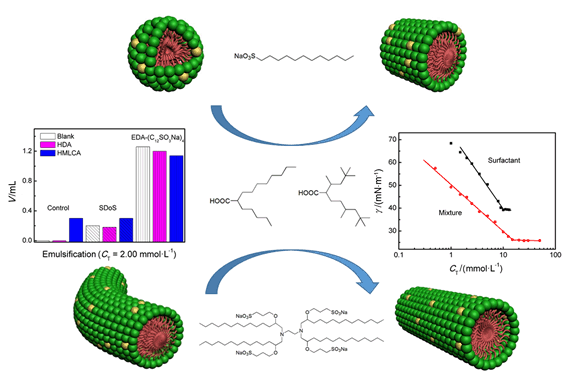| [1] Zana, R. Adv. Colloid Interface Sci. 2002, 97, 205.
[2] Han, Y. C.; Fan, Y. X.; Wu, C. X.; Hou, Y. B.; Wang, Y. L. Sci. Sin. Chem. 2015, 45, 327(in Chinese). (韩玉淳, 范雅珣, 武春娴, 侯研博, 王毅琳, 中国科学:化学, 2015, 45, 327.)
[3] Yoshimura, T.; Ohno, A.; Esumi, K. J. Colloid Interface Sci. 2004, 272, 191.
[4] Yoshimura, T.; Yoshida, H.; Ohno, A.; Esumi, K. J. Colloid Interface Sci. 2003, 267, 167.
[5] In, M.; Bec, V.; Aguerre-Chariol, O.; Zana, R. Langmuir 2000, 16, 141.
[6] In, M.; Aguerre-Chariol, O.; Zana, R. J. Phys. Chem. B 1999, 103, 7747.
[7] Danino, D.; Talmon, Y.; Levy, H.; Zana, R. Science 1995, 269, 1420.
[8] Esumi, K.; Taguma, K.; Koide, Y. Langmuir 1996, 12, 4039.
[9] Kastner, U.; Zana, R. J. Colloid Interface Sci. 1999, 218, 468.
[10] Zana, R.; Levy, H.; Papoutsi, D.; Beinert, G. Langmuir 1995, 11, 3694.
[11] Menger, F. M.; Migulin, V. A. J. Org. Chem. 1999, 64, 8916.
[12] Menger, F. M.; Keiper, J. S. Angew. Chem. Int. Ed. 2000, 39, 1906.
[13] Laschewsky, A.; Wattebled, L.; Arotcarena, M.; Habib-Jiwan, J.; Rakotoaly, R. H. Langmuir 2005, 21, 7170.
[14] Wattebled, L.; Laschewsky, A.; Moussa, A.; Habib-Jiwan, J. Langmuir 2006, 22, 2551.
[15] Yoshimura, T.; Esumi, K. Langmuir 2003, 19, 3535.
[16] Sumida, Y.; Oki, T.; Masuyama, A.; Maekawa, H.; Nishiura, M.; Kida, T.; Nakatsuji, Y.; Ikeda, I.; Nojima, M. Langmuir 1998, 14, 7450.
[17] Hou, Y. B.; Han, Y. C.; Deng, M. L.; Xiang, J. F.; Wang, Y. L. Langmuir 2010, 26, 28.
[18] Wu, C. X.; Hou, Y. B.; Deng, M. L.; Huang, X.; Xiang, J. F.; Liu, Y.; Li, Z. B.; Wang, Y. L. Langmuir 2010, 26, 7922.
[19] Fan, Y. X.; Hou, Y. B.; Xiang, J. F.; Yu, D. F.; Wu, C. X.; Tian, M. Z.; Wang, Y. L. Langmuir 2011, 27, 10570.
[20] Murguia, M. C.; Cabrera, M. I.; Guastavino, J. E.; Grau, R. J. Colloids Surf., A 2005, 262, 1.
[21] Zhou, C. C.; Wang, F. Y.; Chen, H.; Li, M.; Qiao, F. L.; Liu, Z.; Hou, Y. B.; Wu, C. X.; Fan, Y. X.; Liu, L. B.; Wang, S.; Wang, Y. L. ACS Appl. Mater. Interfaces 2016, 8, 4242.
[22] Zhou, C. C.; Wang, D.; Cao, M. W.; Chen, Y.; Liu, Z.; Wu, C. X.; Xu, H.; Wang, S.; Wang, Y. L. ACS Appl Mater Interfaces 2016, 8, 30811.
[23] Jurasin, D.; Habus, I.; Filipovic-Vincekovic, N. Colloids Surf., A 2010, 368, 119.
[24] Qiao, F. L.; Wang, M. N.; Liu, Z.; Fan, Y. X.; Wang, Y. L. Chem. Asian J. 2016, 11, 2763.
[25] Tian, M. Z.; Fan, Y. X.; Ji, G.; Wang, Y. L. Langmuir 2012, 28, 12005.
[26] Wang, T. F.; Shang, Y. Z.; Peng, C. J.; Liu, H. L. Acta Chim. Sinica 2009, 67, 1159(in Chinese). (王腾芳, 尚亚卓, 彭昌军, 刘洪来, 化学学报, 2009, 67, 1159.)
[27] Sadeghi, R.; Shahabi, S. J. Chem. Thermodynamics 2011, 43, 1361.
[28] Xu, G. Y.; Gu, Y. H.; Zeng, L. R.; Zhu, H. P.; Mao, H. Z. Acta Phys. Chim. Sin. 1992, 8, 352(in Chinese). (徐桂英, 顾影慧, 曾利容, 竺和平, 毛宏志, 物理化学学报, 1992, 8, 352.)
[29] Zhu, B. Y.; Zhao, G. X. Fine Chemicals 1985, 2, 1(in Chinese). (朱(王步)瑶, 赵国玺, 精细化工, 1985, 2, 1.)
[30] Vora, S.; George, A.; Desai, H.; Bahadur, P. J. Surfactants Deterg. 1999, 2, 213.
[31] Singh, O. G.; Ismail, K. J. Surfactants Deterg. 2008, 11, 89.
[32] Azum, N.; Naqvi, A. Z.; Akram, M.; Kabir-ud-Din J. Colloid Interface Sci. 2008, 328, 429.
[33] Xue, J. Y.; Liu, T. S.; Liu, Y. C. J. Dispersion Sci. Technol. 2012, 33, 599.
[34] Hayter, J. B.; Penfold, J. Colloid Polym. Sci. 1983, 261, 1022.
[35] Tanford, C. J. Phys. Chem. 1972, 76, 3020.
[36] Chen, Z. D.; Penfold, J.; Li, P. X.; Doutch, J.; Fan, Y. X.; Wang, Y. L. Soft Matter 2017, 13, 8980.
[37] Holland, P. M.; Rubingh, D. N. J. Phys. Chem. 1983, 87, 1984.
[38] Rosen, M. J.; Gao, T.; Nakatsuji, Y.; Masuyama, A. Colloids Surf., A 1994, 88, 1.
[39] Liu, L.; Rosen, M. J. J. Colloid Interface Sci. 1996, 179, 454. |
